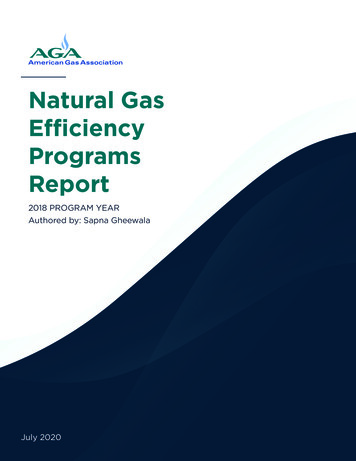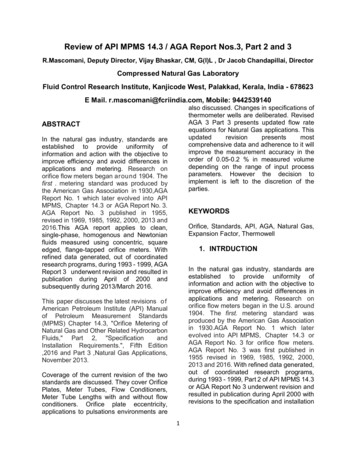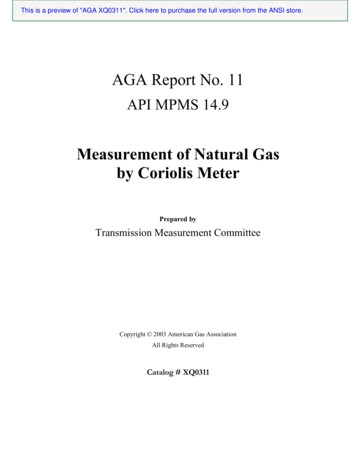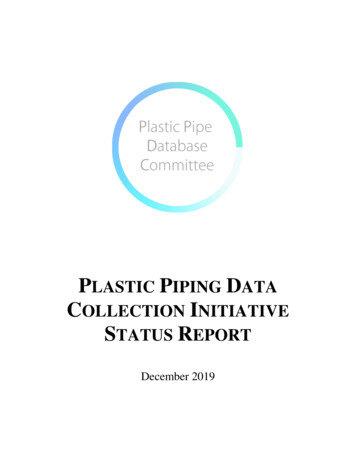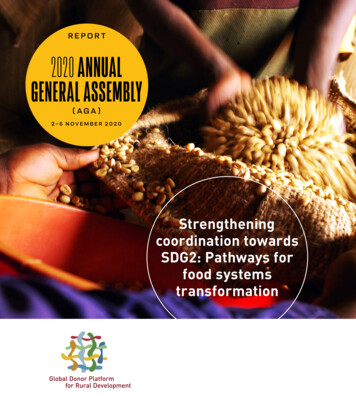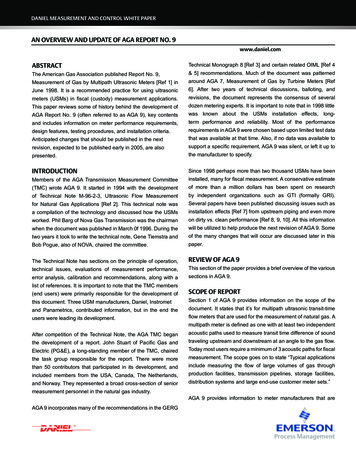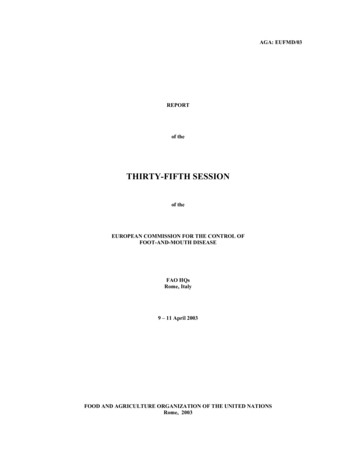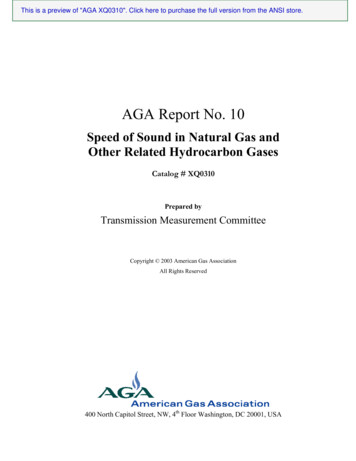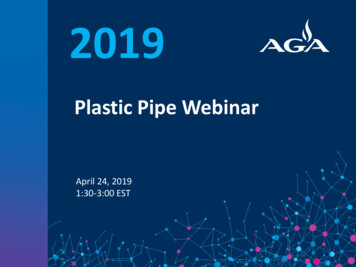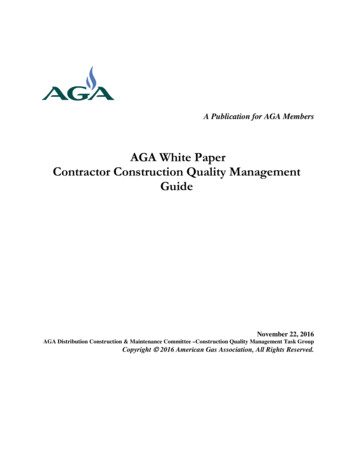
Transcription
A Publication for AGA MembersAGA White PaperContractor Construction Quality ManagementGuideNovember 22, 2016AGA Distribution Construction & Maintenance Committee –Construction Quality Management Task GroupCopyright 2016 American Gas Association, All Rights Reserved.
DISCLAIMER AND COPYRIGHTThe American Gas Association’s (AGA) Operations and Engineering Section provides a forum for industryexperts to bring their collective knowledge together to improve the state of the art in the areas of operating,engineering and technological aspects of producing, gathering, transporting, storing, distributing,measuring and utilizing natural gas.Through its publications, of which this is one, AGA provides for the exchange of information within thenatural gas industry and scientific, trade and governmental organizations. Many AGA publications areprepared or sponsored by an AGA Operations and Engineering Section technical committee. While AGAmay administer the process, it does not write the document and neither AGA nor the technical committeeindependently tests, evaluates or verifies the accuracy of any information or the soundness of any judgmentscontained therein.AGA disclaims liability for any personal injury, property or other damages of any nature whatsoever,whether special, indirect, consequential or compensatory, directly or indirectly resulting from thepublication, use of or reliance on AGA publications. AGA makes no guaranty or warranty as to the accuracyand completeness of any information published therein. The information contained therein is provided onan “as is” basis and AGA makes no representations or warranties including any expressed or impliedwarranty of merchantability or fitness for a particular purpose.In issuing and making this document available, AGA is not undertaking to render professional or otherservices for or on behalf of any person or entity. Nor is AGA undertaking to perform any duty owed by anyperson or entity to someone else. Anyone using this document should rely on his or her own independentjudgment or, as appropriate, seek the advice of a competent professional in determining the exercise ofreasonable care in any given circumstances.AGA has no power, nor does it undertake, to police or enforce compliance with the contents of thisdocument. Nor does AGA list, certify, test or inspect products, designs or installations for compliance withthis document. Any certification or other statement of compliance is solely the responsibility of the certifieror maker of the statement.AGA does not take any position with respect to the validity of any patent rights asserted in connection withany items that are mentioned in or are the subject of AGA publications, and AGA disclaims liability for theinfringement of any patent resulting from the use of or reliance on its publications. Users of thesepublications are expressly advised that determination of the validity of any such patent rights, and the riskof infringement of such rights, is entirely their own responsibility.Users of this publication should consult applicable federal, state and local laws and regulations. AGA doesnot, through its publications intend to urge action that is not in compliance with applicable laws, and itspublications may not be construed as doing so.Changes to this document may become necessary from time to time. If changes are believed appropriate byany person or entity, such suggested changes should be communicated to AGA in writing and sent to:Operations & Engineering Section, American Gas Association, 400 North Capitol Street, NW, 4th Floor,Washington, DC 20001, U.S.A. Suggested changes must include: contact information, including name,address and any corporate affiliation; full name of the document; suggested revisions to the text of theContractor Construction Quality Management 2016 AGA2 Page
document; the rationale for the suggested revisions; and permission to use the suggested revisions in anamended publication of the document.Copyright 2016, American Gas Association, All Rights Reserved.Contractor Construction Quality Management 2016 AGA3 Page
AcknowledgementThe Construction Quality Management Task Group, contributing to the development of thiswhite paper included:Robert Benson – National GridEd Estanislao – Southwest Gas CorporationTim Lauder – PSE&GBuddy Powell – ATMOS EnergyTom Rieth – Louisville Gas & ElectricVictoria Sorvillo Weidemann – Con EdisonMark White / Rob Conaway – Southern Cal GasSteve Wieczorek / David Spangler– Washington Gas Light CoContractor Construction Quality Management 2016 AGA4 Page
Contractor Construction Quality Management GuideI.PURPOSE and SCOPEThe intent of this white paper is to provide guidance for the implementation of a Quality ManagementProgram during construction of Pipeline Facilities by an operator’s contractor. This is guidance only.Practices may be different for different companies based on size, geography, system variables, etc.There was a separate effort to create a white paper that addresses the broader concept of QualityManagement for Gas Operations. See “Developing and Implementing a Quality Assurance Program forNatural Gas Operations”, November 5, 2015.This white paper is directed to only quality management of construction by contractors. It assumes thatissues such as Quality Leadership, Management Commitment, Responsibilities, Authorities andResources have been established.The Guidance is broken down into the broad categories that follow the timeline of a typical ConstructionProject.These categories include: Project Initiation – Section IIIpages 8 - 15 Project Preparation – Section IVpages 16-20 Inspection – Section Vpages 21-37 Documentation – Section VIpages 38-39 Performance Measurement – Section VIIpage 40Contractor Construction Quality Management 2016 AGA5 Page
II.DEFINITIONSCompany Authorized Representative is a generic term for someone employed by the operatorwith the authority to assess compliance with terms of the contract or specifications. This personmay be involved with the project such as a Project Manager or Construction Manager. Or, thisperson may have back office responsibility for review of records. Unlike the inspector, thisindividual may or may not visit the construction site. Contract – The written agreement executed by the operator and contractor that details theobligations of the parties, including but not limited to standards for the performance of thework, furnishing of labor, equipment and materials, and the basis of payment. Contractor is a person or company, independent of the operator, who agrees to furnishmaterials, services or personnel that meet the specifications of the operator and applicablestandards at a mutually agreed price. Inspection is the action of reviewing, witnessing and/or verifying that the task/work has beencompleted satisfactorily and in conformance with all applicable standards and specifications. Inspector is a generic term for any individual assigned responsibility for inspection. Theindividual assigned to perform the inspection should not perform the construction task requiringinspection. This individual typically works in the field.An inspector should have an appropriate level of training or experience with the requisiteknowledge, skills and abilities to complete an assigned inspection. Such training may include:on-the-job training, classroom instruction, demonstrations, or other methods deemedappropriate by the operator. Prior construction or supervisory experience may be an acceptablesubstitute for some of the training. Some operators may choose to include inspectors in theirOperator Qualification process.Inspectors may be the operator’s employee, contractor’s employee and/or a third party. Titlesvary for the individuals performing inspections and include inspector, oversight personnel, aCompany Authorized Representative, and/or Job Supervisor/Foreman. Project - The unit price, lump sum or time & material work as defined by the terms andconditions of the construction contract. Operator as defined in 49 CFR 192.3 is an individual, firm, joint venture, partnership,corporation, association, state, municipality, cooperative association, or joint stock association,and including any trustee, receiver, assignee, or personal representative thereof who engages inthe transportation of gas. Quality is conformance to requirements. It is the characteristics of a product or service whichupholds its ability to satisfy stated or implied needs.Contractor Construction Quality Management 2016 AGA6 Page
Quality Performance Standard – Zero Defects. Quality Assurance (QA) comprises those actions necessary to provide adequate confidence thatproducts, processes or systems comply with requirements such as specifications and standards.The focus is on providing assurance that processes are adequate and effective. Quality Control (QC) comprises operational techniques and activities, including inspections,necessary to control the characteristics of a product or service (i.e. characteristics that can bemeasured against codes, drawings, specifications). The focus is on preventing defective productsor services from being passed on. Specifications – documentation which describes the work, which supports the plans, and whichdescribes the types and qualities of materials and equipment, the methods of installation of suchmaterials and equipment, and the results to be achieved. Standards A group of documents that specify requirements for construction and operation ofnatural gas pipelines. These include The Minimum Federal Safety Standards (49 CFR 192) andstandards issued by other organizations and incorporated by reference in Part 192. UnlikeSpecifications created by the operator, these are typically written by organizations beyond thecontrol of the operator.Contractor Construction Quality Management 2016 AGA7 Page
III.PROJECT INITIATIONA.Establishing Roles and/or ResponsibilitiesThere may be several individuals involved in any one construction project. It isimportant that the roles and expectations be discussed and agreed before the projectstarts. Roles to be discussed include:1.WorkersThe workers on the job should be responsible to safely perform their work inaccordance with procedures. They should be able to stop a job for any safety orcompliance issues; and should be able to raise those issues without fear of reprisal.The worker must be Operator Qualified (OQ) to perform an OQ task independently.Unqualified workers can perform some OQ tasks when under the direct observationof a qualified individual.Some tasks such as tapping an energized pipeline, welding, fusion, and/or joiningpipe, can only be performed by qualified workers.Workers are responsible for both personal and pipeline safety. This includesverifying that they have the applicable personal protective equipment (PPE)required to be worn/utilized on the jobsite in accordance with procedures, theproper equipment, materials, tools and available standards/procedures.2.Job Supervisor / ForemanThe contractor’s Job Supervisor or Foreman is responsible for the safe completion ofthe assigned work within the limits of the design specifications and procedures.Contractor titles for this person may vary to include a wide range of contractormanagement. This is typically the person to whom the inspector raises issues.The contractor’s Job Supervisor or Foreman is responsible to verify that all workersare in compliance with PPE requirements per the applicable procedures and that allappropriate and applicable work area protection is in place on the jobsite. Thecontractor’s Job Supervisor or Foreman is also responsible for pipeline safety issuesand determining that the proper materials are used and proper constructiontechniques are followed. This person verifies the protection of people and propertyduring the safe completion of the work.Contractor Construction Quality Management 2016 AGA8 Page
3.InspectorAs listed in the definitions, the inspector is responsible to review, witness and/orverify that the work has been completed satisfactorily. As in other steps ofconstruction, during any inspection, work stoppage should occur if certain noncompliance is observed.In the course of inspection, if certain phases of the work are not being done inaccordance with the plans and specifications (non-conformances), or when otherproblems occur, these errors, violations, or problems should be documented andreported to the appropriate operator or contractor designated representative forfurther action.The inspector should be able to fully read, comprehend, and interpret the contract,plans and specifications. The inspector typically does not have the authority tounilaterally alter any specification or design requirements. However, the inspectorwould be integral to any change management process by identifying the need for achange and passing the supporting information through the change managementprocess.The inspector may be involved in the review and acceptance of any projectdocumentation from the contractor. This includes as-built documentation andcontractual documentation.4.Company AuthorityThis is the individual with the authority to change specification requirements aftercompletion of whatever internal change management process is in effect.5.Public RelationsThere should be an understanding between the inspector and/or CompanyAuthorized Representative and the Job Supervisor / Foreman regarding contact withthe public and the customers.6.Media RelationsThere should be an understanding of who is authorized to answer media inquiriesregarding the construction project. Typically the operator’s media relationspersonnel would handle all such inquiries after consultation with the inspector and /or Job Supervisor.Contractor Construction Quality Management 2016 AGA9 Page
Ethics7.It is important that the actions of the operator and the contractor be conducted tothe highest ethical standards. Follow policies and pro
The intent of this white paper is to provide guidance for the implementation of a Quality Management Program during construction of Pipeline Facilities by an operator’s contractor. This is guidance only. Practices may be different for different companies based on size, geography, system variables, etc. There was a separate effort to create a white paper that addresses the broader concept of Quality
